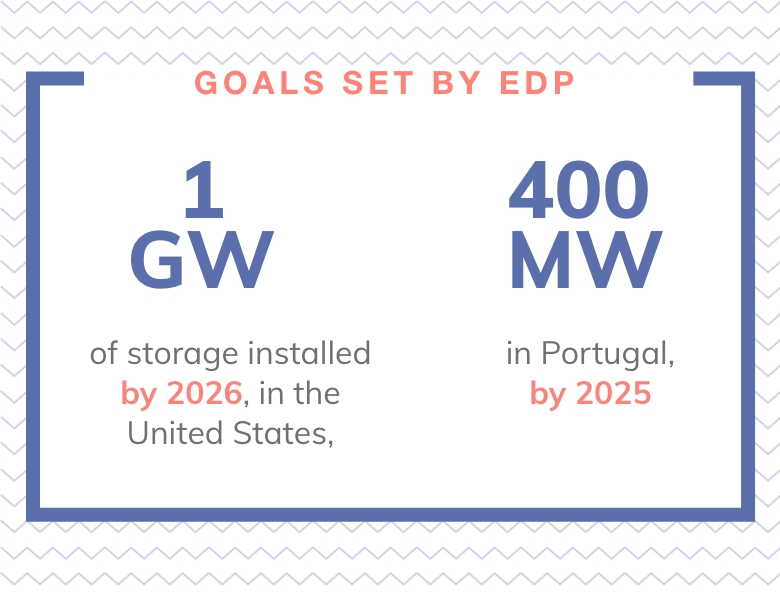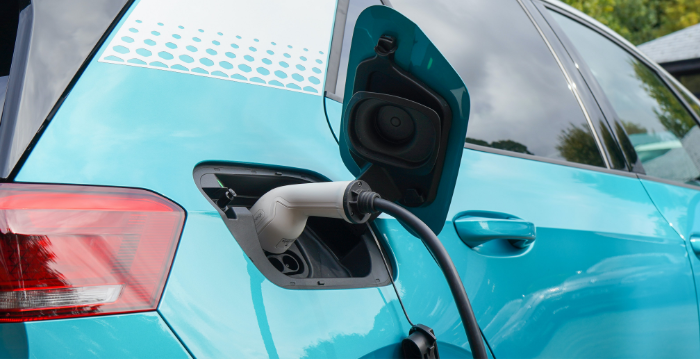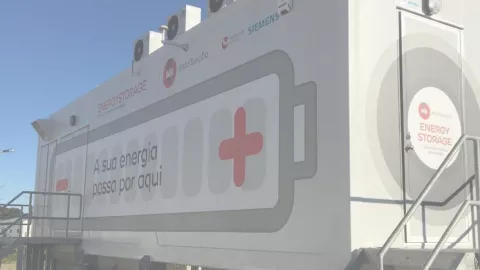When non-hydro renewable energies emerged on the market, mainly solar and wind, they brought new methods of electricity production, to take advantage of the geographical and climatic advantages of countries. But these had a high cost of production compared to fossil technologies. In a few decades, the scale began to tip to the sun and wind side, and these are increasingly used in generation. In order to fight climate change and decarbonize the planet, it is critical to eliminate the use of fossil fuels, increase electrification and invest in renewable energies, but there is still an obstacle to overcome: It's intermittency. This is where energy storage has an important role to play.
"2050 may seem 30 years away but, in fact, it is tomorrow already," recalls André Botelho, from EDP Innovation, being that storage is "a core piece for decarbonization".
A path to carbonic neutrality
For EDP Inovação's Energy Storage & Flexibility manager, carbon neutrality (link to Carbonic Neutrality theme) - European goal for 2050 - should always be present in companies, governments and actions. Bearing this in mind, "energy storage is a central part of decarbonization." According to André Botelho, in a context where renewables will be increasingly important, storing energy "allows bringing the flexibility that the system had before."
The European Association for Energy Storage (EASE) also sees storage as a key element in the energy transition, and is able to ease the meeting of the goals of the European Green Agreement. EASE highlights six advantages in storage:
- By facilitating the integration of a higher percentage of renewables into the network, storage helps in meeting the decarbonization targets for 2030 and 2050;
- Investing in research, demonstration, and launch of storage solutions allows the European Union to ensure global leadership in clean technologies;
- Storage helps in the transition of coal and energy-intensive regions and infrastructure, as well as islands, heavily dependent on fossil fuels;
- Private storage solutions enhance energy efficiency and optimization, and increase citizen engagement;
- Storage supports the decarbonization of transportation and mobility, in order to achieve the European Union's zero pollution ambitions;
- Liquid or gaseous storage strengthen flexibility in even wider deadlines, with effects on the decarbonization of the European economy.
André Botelho insists that "we need to electrify, for the sake of energy efficiency, decarbonization, but we also need to stop emitting human impact CO2. It is in this path of decarbonization and electrification that storage is central. " Changes in individual consumption - from household appliances to heating, to electric vehicles - but also in industries, lead to an increased difficulty in managing electrical distribution networks. Storage helps the system from "being disrupted as little as possible with all the disruption that is being created in it," summarizes the leader of EDP Innovation, giving as an example the solar panels for self-consumption: "Whoever wants to have solar panels in their home, might need only a few, because when you're not at home, what they produce disappears. If you want more energy or to save energy for later, storage is very important.
Storage grows to keep pace with generation
Also, Pablo Berruecos, who leads the new energy storage unit of the EDP Renováveis in North America, believes that energy storage "is an important part" of decarbonization, and highlights that the growth of renewables is now directly linked to the growth of storage solutions". The two components "will certainly continue to reduce the use of fossil fuels for energy production." What is lacking, according to the expert, is "the commitment of society itself" and also a friendlier "regulation", which facilitates this transition.
Eduardo Ruano Rodrigues, project manager at NEW, recalls that there are already public tenders, at the European level, for renewable installations where the storage component is mandatory. "The vision indicates that it is strictly necessary, coupled with renewable energy production, to have the ability to store it," he explains. Something EDP Renováveis has already done in a wind and photo-voltaic farm in Romania, and is also developing in California in the Sonrisa solar park, which is scheduled to be operational in 2022.



"The vision indicates that it is strictly necessary, coupled with renewable energy production, to have the ability to store it."
Eduardo Ruano Rodrigues, from EDP NEW
In Portugal, in the city of Évora, since 2015, the Energy Storage pilot project, promoted by E-REDES (a regulated company of the EDP group for electricity distribution in Portugal), continues to test both the energy supply and the connection to the network. According to Eduardo Ruano Rodrigues, "for a company like EDP, which incorporates business units, legacy of a classic and vertically integrated structure, focused on the generation, transportation, distribution and commercialization of electricity, the storage of energy arises as a fourth element to be explored, fundamental in guaranteeing the maximization of the operational efficiency along the value chain."
This fourth element gains even more weight in the face of EDP's goals of achieving Carbonic Neutrality by 2030, consolidating itself as a leader in the energy transition. "We have to see this from the point of view of the challenge, but also to realize that the biggest goal is there. In the next 9 years, in addition to releasing everything that is non-renewable in a portfolio, it is in carbon neutrality that we are committed to", explains André Botelho. He recalls that "we have to do this as a society, as governments, as organizations, as people. It has to be something we do together". And people are increasingly involved in the change: "Before, electricity was something that this life span EDP treated, we only turned on the light and knew nothing else. Now, more and more, we talk to neighbors about energy communities, how to produce energy, and how to make it cheaper. This involves us all in a very interesting way".
EDP leaves coal by 2025 and will be carbon neutral by 2030. That path also goes through the bet on energy storage.
Asia and the United States at the forefront
The International Energy Agency (IEA) has placed South Korea, China, the United States and Germany as the countries that have invested the most in energy storage since 2016, accounting for about two-thirds of the total installed GW. Although the 2020 IEA report indicates that there was a global slowdown in these investments in 2019, the pandemic did not delay the progression of these solutions. An estimate by IHS Markit puts the increase of 2020 at 4.5 GW (50% above the previous year) and launches the forecast of 10 GW in new energy stores in 2021. According to IHS Markit, although the US and Asia are the biggest drivers of these technologies, Europe will have "70% growth in installations" in 2021.
In the United States, Pablo Berruecos highlights the growth of storage solutions, including private usage, associated with the self-consumption of solar panels, but recalls that "making the numbers right" is necessary. Without incentives, it is difficult to find a way to achieve profitability in some markets and the balance between costs and benefits - whether for generating companies or for consuming families seeking to save - remains the main challenge. Still, "we can see a greater interest in general, especially in electrical utilities that have it easier in finding funding, and energy purchase agreements are emerging for different levels of risk, which are a new thing in the US", says the EDPR representative, enthusiastic about the future.
Pablo Berruecos points out that in the energy market of Texas, called ERCOT (Electric Reliability Council of Texas), "this year only, 1 GW of energy storage will be installed, and 5 GW in the next three years." And also in California "most new solar parks are accompanied by a storage unit." In addition, "there is a more environmentally friendly and renewable administration [Biden], we can count on the emergence of more incentives for energy storage."


The push on electric vehicles
Electric mobility, which is leading to a change in consumption, is also driving the development of battery-centric storage solutions. "It is the main driver for cost reduction," explains André Botelho, "because the transportation sector is really moving strongly towards electrification and decarbonization." The manager of EDP Inovação sees more difficulties in the adoption of batteries for home usage, but believes it will be the next step: "We are looking into how to bring the highest value or how to have offers that can be distinctive, so that self-consumption becomes more of a reality".
For André Botelho, electric mobility helps to lower storage costs, "because the transportation sector is moving strongly in electrification and decarbonization".
Storage: Solution to modernize plants
Pablo Berruecos points out, on the other hand, that energy storage solutions help in redesigning old-fashioned and polluting plants, with benefits for both the operation and the planet. "In aged assets, we need to take into account that energy storage can help in the costs of upgrades, repairs, it can help improve the overall costs of an installation. There is a great opportunity in this field, in improving the financial efficiency of these assets", explains the representative.
The usage of surplus energy, reduction of fossil fuels consumption, reformulation of polluting plants, better management of distribution networks, support for electrification, and new consumption, such as electric mobility. These are just some of the advantages of energy storage, and they also demonstrate the necessary changes of society in order to achieve carbon neutrality. "Without this flexibility of energy storage piece, we can't get there", summarizes André Botelho.
energy storage
Storing energy for a better future
If renewable energy is one of the ways to achieve carbon neutrality, energy storage ensures its effectiveness. All so that solar and wind energy can continue to grow and so that the need for fossil fuels is ever less.

